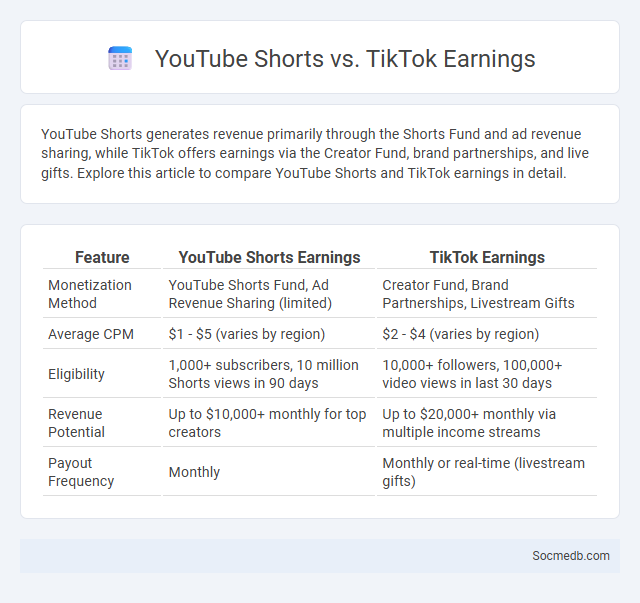
Photo illustration: YouTube Shorts vs TikTok Earnings
YouTube Shorts generates revenue primarily through the Shorts Fund and ad revenue sharing, while TikTok offers earnings via the Creator Fund, brand partnerships, and live gifts. Explore this article to compare YouTube Shorts and TikTok earnings in detail.
Table of Comparison
| Feature | YouTube Shorts Earnings | TikTok Earnings |
|---|---|---|
| Monetization Method | YouTube Shorts Fund, Ad Revenue Sharing (limited) | Creator Fund, Brand Partnerships, Livestream Gifts |
| Average CPM | $1 - $5 (varies by region) | $2 - $4 (varies by region) |
| Eligibility | 1,000+ subscribers, 10 million Shorts views in 90 days | 10,000+ followers, 100,000+ video views in last 30 days |
| Revenue Potential | Up to $10,000+ monthly for top creators | Up to $20,000+ monthly via multiple income streams |
| Payout Frequency | Monthly | Monthly or real-time (livestream gifts) |
Overview: YouTube Shorts vs TikTok Earnings
YouTube Shorts and TikTok both generate significant earnings through ad revenue sharing, brand partnerships, and creator funds, with TikTok reportedly paying creators up to $100 million annually via its Creator Fund. YouTube Shorts monetization relies heavily on the YouTube Partner Program and Shorts Fund, attracting creators with the platform's massive global user base exceeding 2 billion logged-in monthly users. While TikTok offers rapid virality and direct influencer marketing opportunities, YouTube Shorts benefits from integration within the larger Google ad ecosystem, providing potentially higher long-term revenue for content creators.
Monetization Models: YouTube Shorts vs TikTok
YouTube Shorts employs a monetization model primarily through the YouTube Partner Program, allowing creators to earn revenue from ads displayed on their Shorts, supplemented by the Shorts Fund that incentivizes popular content. TikTok's monetization model revolves around the TikTok Creator Fund, brand partnerships, and in-app gifting during live streams, providing multiple revenue streams for influencers. Both platforms leverage short-form video content to attract massive audiences, but YouTube offers deeper integration with its ad ecosystem, while TikTok emphasizes direct creator-fan monetization.
Creator Fund Comparisons: Shorts vs TikTok
The YouTube Shorts Creator Fund allocates $100 million to reward video creators based on viewership metrics and engagement, emphasizing content quality and consistency. TikTok's Creator Fund, valued at $200 million, offers payments calculated through video views, engagement, and region-specific rates, promoting viral and niche content creators alike. Both platforms incentivize content creation but differ in payout models, with TikTok favoring broader reach while YouTube Shorts emphasizes sustained audience interaction.
Ad Revenue: Breaking Down Earnings Per Platform
Social media platforms generate substantial ad revenue, with Facebook leading by earning over $115 billion annually from advertisements across its apps. Instagram and YouTube follow closely, contributing $45 billion and $40 billion respectively, driven by targeted ads and video content. Maximizing your marketing strategy requires understanding these platforms' earnings and audience engagement to optimize your ad spend effectively.
Brand Partnerships: Opportunities on Shorts and TikTok
Brand partnerships on Shorts and TikTok offer unprecedented opportunities for businesses to boost visibility and engage younger demographics through creative, short-form video content. These platforms provide advanced targeting algorithms that enable brands to reach specific audiences effectively, maximizing ROI on marketing campaigns. Collaborations with popular influencers on TikTok and Shorts can amplify brand messages, driving higher engagement rates and fostering authentic connections with viewers.
Audience Engagement and Earning Potential
Maximizing audience engagement on social media involves creating interactive content, utilizing analytics to understand follower behavior, and leveraging platform-specific features like stories and live videos. High engagement rates directly correlate with increased earning potential through brand partnerships, sponsored posts, and affiliate marketing campaigns. Influencers and businesses who consistently engage their audiences can command premium rates and unlock diverse monetization opportunities.
Regional Earnings Differences: Shorts vs TikTok
Regional earnings differences between Shorts and TikTok reveal significant disparities influenced by local advertising rates and user engagement. TikTok creators in North America and Western Europe tend to earn higher revenue due to established brand partnerships and larger advertising budgets, while Shorts content monetization often benefits creators in emerging markets with growing user bases. Understanding these regional trends is crucial for maximizing income potential on each platform.
Algorithm Impact on Monetization
Social media algorithms prioritize content that maximizes user engagement, directly influencing creators' monetization opportunities by increasing visibility and ad revenue potential. Platforms like Instagram and YouTube adjust feeds based on user behavior, promoting content that keeps users active longer, which in turn boosts creator earnings through sponsored posts and affiliate marketing. Algorithm changes can significantly affect income streams, making it essential for creators to constantly adapt their strategies to maintain and grow their revenue.
Success Stories: Top Earners on Shorts and TikTok
Top earners on Shorts and TikTok have transformed their content creation skills into lucrative careers, generating income from millions of views and brand partnerships. These success stories highlight the potential for viral videos to attract sponsorship deals, merchandise sales, and fan monetization. Understanding the strategies behind their growth can help you replicate their achievements and maximize your own social media revenue streams.
Future Earnings Trends: YouTube Shorts vs TikTok
YouTube Shorts is rapidly gaining traction as a monetization platform, offering creators YouTube's established ad revenue share model, which often results in higher earnings per view compared to TikTok's Creator Fund payouts. TikTok's monetization is growing with options like live gifts and brand partnerships, but its revenue per thousand views (RPM) tends to be lower and more variable. Understanding these trends helps you optimize content strategy to maximize future earnings across both platforms.
 socmedb.com
socmedb.com